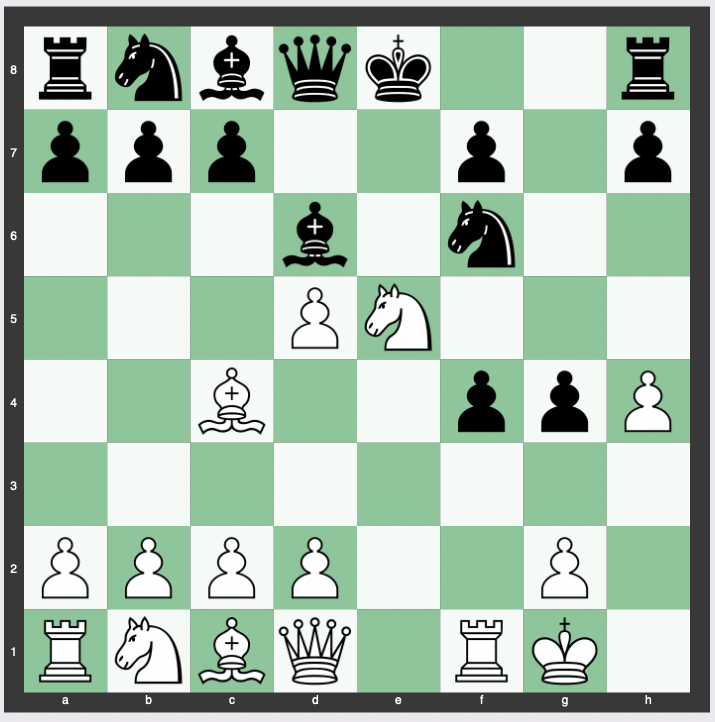The Rice Gambit is a fascinating chess opening strategy that originates from the King’s Gambit Accepted, specifically an offshoot of the Kieseritzky Gambit.
This approach is characterized by a sequence of moves that leads to an offer of a knight’s sacrifice by White to secure their king and prepare a rook for an offensive against Black’s underdeveloped position.
Despite its initial allure, the gambit has fallen out of favor in serious gameplay due to its inherent flaws.
Move Order of the Rice Gambit
The move order of the Rice Gambit is:
1. e4 e5 2. f4 exf4 3. Nf3 g5 4. h4 g4 5. Ne5 Nf6 6. Bc4 d5 7. exd5 Bd6 8. O-O
Which yields this position:

Birth of the Rice Gambit
The Rice Gambit was intensely championed by Isaac Rice, a German-born American businessman, in the late 19th century.
An ardent enthusiast of this tactic, Rice sponsored many theme-based tournaments where the Rice Gambit was the opening move in every game.
Legacy and Popularity
Prominent figures in the chess world such as Emanuel Lasker, Mikhail Chigorin, Carl Schlechter, Frank Marshall, and David Janowski have participated in these tournaments, which took place in diverse locations from Monte Carlo and Saint Petersburg to Brooklyn and Trenton Falls.
In 1905, a Pillsbury National Correspondence Chess Association event saw 230 amateurs employing the Rice Gambit via mail.
The Rice Gambit Association
Isaac Rice’s passion for this gambit was so strong that in 1904 he established The Rice Gambit Association in his New York home.
With Dr. Lasker serving as Secretary, the Association went on to publish a book containing all the games played in the themed tournaments.
Critique of the Gambit
Despite its early popularity, concrete analysis over time has shown the gambit to be “neither good nor necessary”.
The strategy has since been abandoned in serious play, standing as “a grotesque monument to a rich man’s vanity.”
Analysis and Evaluations
The Rice Gambit variation of the King’s Gambit is generally evaluated at around -2.60 to -3.20 for white (black advantage).
Chess expert Gallagher in 1992 commented, “Basically, White sacrifices a piece and castles into a raging attack, but according to theory, he miraculously holds the balance.
Nevertheless, I still advise you to steer well clear of it.”
The Encyclopedia of Chess Openings (1997) provided a detailed analysis of possible move sequences resulting in a draw by perpetual check, which they attributed to José Raúl Capablanca, Amos Burn, and Edward Lasker.
Continuation lines might include:
8… Nbd7 9. d4 Nxe5 10. Qe1 O-O 11. dxe5 Bc5+ 12. Kh1 Ne4 13. Bxf4 Nf2+ 14. Rxf2 Qxh4+ 15. Kg1 g3 16. Bxg3 Qxg3 17. Nc3 Bf5 18. Na4 Bd4 19. c3 Be3 20. Kf1 Bxf2 21. Qxf2 Bd3+ 22. Bxd3 Qxd3+ 23. Kg1 Qxd5 24. Re1 b6 25. c4 Qxc4 26. Nc3 f5 27. exf6 Qc5 28. Qxc5 bxc5 29. Re6 Rab8 30. Ne4 Rfe8
8… Nbd7 9. Qe1 Bc5+ 10. Kh1 O-O 11. Rxf4 Nxe5 12. Qxe5 Nxd5 13. Rf1 Qxh4+ 14. Qh2 Qxh2+ 15. Kxh2 Bd6+ 16. Kg1 Nb6 17. Bb3 a5 18. c3 a4 19. Bc2 f5 20. d4 Bd7 21. Na3 Kg7 22. c4 Bxa3 23. bxa3 Nxc4 24. Bf4
8… Nbd7 9. Qe1 Nxe5 10. d4 O-O 11. dxe5 Bc5+ 12. Kh1 Ne4 13. Bxf4 Nf2+ 14. Rxf2 Qxh4+ 15. Kg1 g3 16. Bxg3 Qxg3 17. Nd2 Re8 18. e6 Qxf2+ 19. Qxf2 Bxf2+ 20. Kxf2 fxe6 21. Re1 Rf8+ 22. Kg3 exd5 23. Bxd5+ Kh8 24. Re7 Rd8 25. Ne4 Bf5 26. Bxb7 Rg8+ 27. Kf3 Rab8 28. Rxc7 Rg7 29. Rxg7 Kxg7
ECO C39 King’s gambit accepted, Kieseritsky, Rice gambit (White perspective)
Further Insight
More recently, Shaw in 2013 proposed, “After the following accurate (and by no means obvious) sequence Black is better: 8 … Bxe5 9. Re1 Qe7! 10. c3 f3! 11. d4 Ne4! 12. Rxe4 Bh2+ 13. Kxh2 Qxe4”
This demonstrates that skilled, observant play from Black can tip the balance of the game.
3 Gambits With EXTREME Win Rates! Rice Gambit, Lobster Gambit, Corkscrew Gambit
Conclusion
The Rice Gambit, while once promoted with great enthusiasm, serves as an intriguing case study in the evolution of chess strategies.
Although it has been deemed flawed and largely abandoned in professional gameplay, the gambit offers valuable lessons in the importance of strategic analysis and evolution in the game of chess.
Its enduring legacy remains as a testament to a time when a wealthy businessman’s passion influenced the chess world’s exploration of new strategies.


